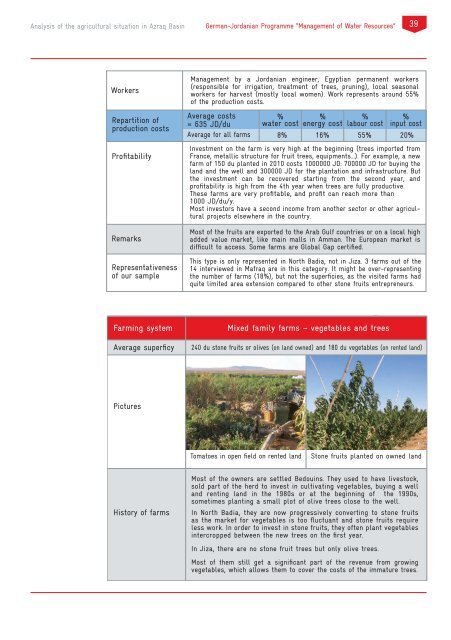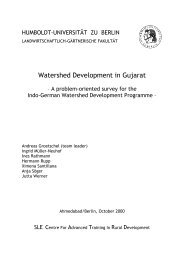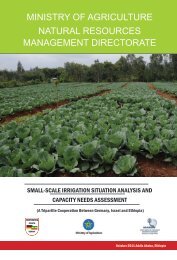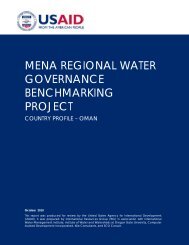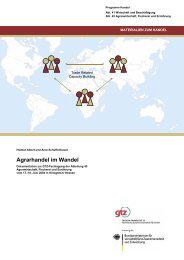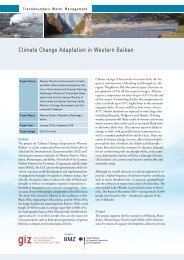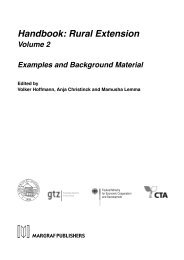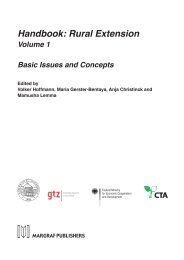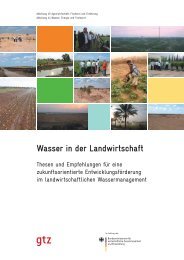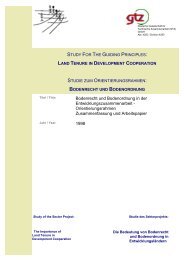Farming in the - WordPress.com
Farming in the - WordPress.com
Farming in the - WordPress.com
You also want an ePaper? Increase the reach of your titles
YUMPU automatically turns print PDFs into web optimized ePapers that Google loves.
Analysis of <strong>the</strong> agricultural situation <strong>in</strong> Azraq Bas<strong>in</strong><br />
German-Jordanian Programme “Management of Water Resources”<br />
39<br />
Workers<br />
Repartition of<br />
production costs<br />
Profitability<br />
Remarks<br />
Representativeness<br />
of our sample<br />
Management by a Jordanian eng<strong>in</strong>eer, Egyptian permanent workers<br />
(responsible for irrigation, treatment of trees, prun<strong>in</strong>g), local seasonal<br />
workers for harvest (mostly local women). Work represents around 55%<br />
of <strong>the</strong> production costs.<br />
Average costs<br />
= 635 JD/du<br />
Average for all farms<br />
%<br />
water cost<br />
%<br />
energy cost<br />
%<br />
labour cost<br />
%<br />
<strong>in</strong>put cost<br />
8% 16% 55% 20%<br />
Investment on <strong>the</strong> farm is very high at <strong>the</strong> beg<strong>in</strong>n<strong>in</strong>g (trees imported from<br />
France, metallic structure for fruit trees, equipments...). For example, a new<br />
farm of 150 du planted <strong>in</strong> 2010 costs 1000000 JD: 700000 JD for buy<strong>in</strong>g <strong>the</strong><br />
land and <strong>the</strong> well and 300000 JD for <strong>the</strong> plantation and <strong>in</strong>frastructure. But<br />
<strong>the</strong> <strong>in</strong>vestment can be recovered start<strong>in</strong>g from <strong>the</strong> second year, and<br />
profitability is high from <strong>the</strong> 4th year when trees are fully productive.<br />
These farms are very profitable, and profit can reach more than<br />
1000 JD/du/y.<br />
Most <strong>in</strong>vestors have a second <strong>in</strong><strong>com</strong>e from ano<strong>the</strong>r sector or o<strong>the</strong>r agricultural<br />
projects elsewhere <strong>in</strong> <strong>the</strong> country.<br />
Most of <strong>the</strong> fruits are exported to <strong>the</strong> Arab Gulf countries or on a local high<br />
added value market, like ma<strong>in</strong> malls <strong>in</strong> Amman. The European market is<br />
difficult to access. Some farms are Global Gap certified.<br />
This type is only represented <strong>in</strong> North Badia, not <strong>in</strong> Jiza. 3 farms out of <strong>the</strong><br />
14 <strong>in</strong>terviewed <strong>in</strong> Mafraq are <strong>in</strong> this category. It might be over-represent<strong>in</strong>g<br />
<strong>the</strong> number of farms (18%), but not <strong>the</strong> superficies, as <strong>the</strong> visited farms had<br />
quite limited area extension <strong>com</strong>pared to o<strong>the</strong>r stone fruits entrepreneurs.<br />
<strong>Farm<strong>in</strong>g</strong> system<br />
Average superficy<br />
Mixed family farms – vegetables and trees<br />
240 du stone fruits or olives (on land owned) and 180 du vegetables (on rented land)<br />
Pictures<br />
Tomatoes <strong>in</strong> open field on rented land<br />
Stone fruits planted on owned land<br />
History of farms<br />
Most of <strong>the</strong> owners are settled Bedou<strong>in</strong>s. They used to have livestock,<br />
sold part of <strong>the</strong> herd to <strong>in</strong>vest <strong>in</strong> cultivat<strong>in</strong>g vegetables, buy<strong>in</strong>g a well<br />
and rent<strong>in</strong>g land <strong>in</strong> <strong>the</strong> 1980s or at <strong>the</strong> beg<strong>in</strong>n<strong>in</strong>g of <strong>the</strong> 1990s,<br />
sometimes plant<strong>in</strong>g a small plot of olive trees close to <strong>the</strong> well.<br />
In North Badia, <strong>the</strong>y are now progressively convert<strong>in</strong>g to stone fruits<br />
as <strong>the</strong> market for vegetables is too fluctuant and stone fruits require<br />
less work. In order to <strong>in</strong>vest <strong>in</strong> stone fruits, <strong>the</strong>y often plant vegetables<br />
<strong>in</strong>tercropped between <strong>the</strong> new trees on <strong>the</strong> first year.<br />
In Jiza, <strong>the</strong>re are no stone fruit trees but only olive trees.<br />
Most of <strong>the</strong>m still get a significant part of <strong>the</strong> revenue from grow<strong>in</strong>g<br />
vegetables, which allows <strong>the</strong>m to cover <strong>the</strong> costs of <strong>the</strong> immature trees.


